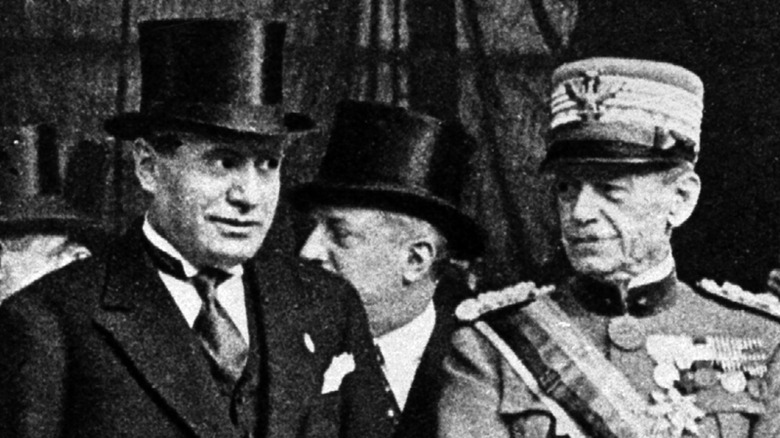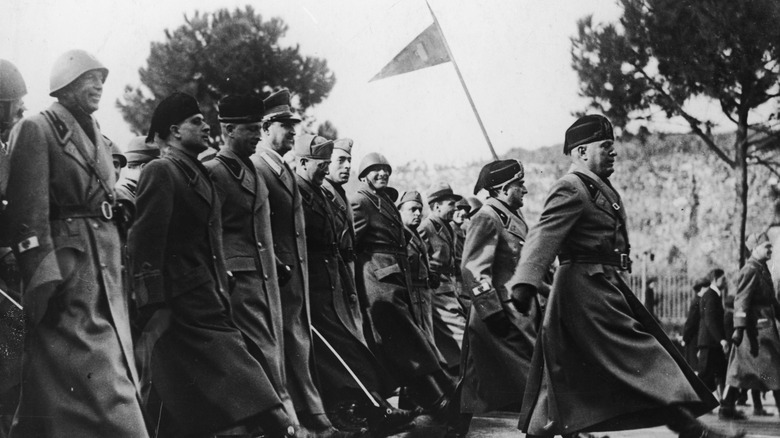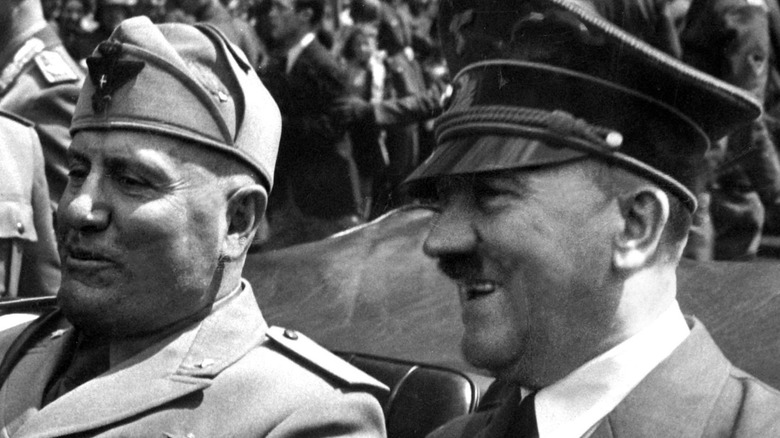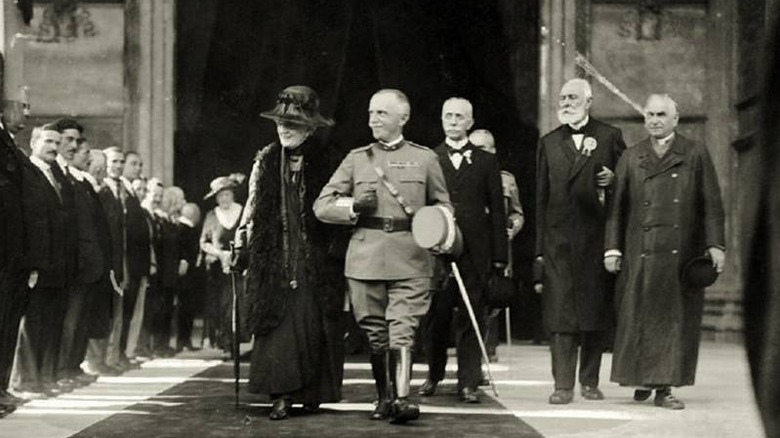Benito Mussolini And King Victor Emmanuel III Of Italy's Relationship Explained
"Politics makes strange bedfellows," as American author Charles Dudley Warner memorably observed. The peculiar connection between the Italian dictator Benito Mussolini and the penultimate King of Italy, Victor Emmanuel III, is an unusual instance of this remark in reality. While it is likely one of the more overlooked power-sharing dynamics in World War II, it still gives an intriguing glimpse into how individuals in power exploit one another as pawns in their desperation to stay on top. The symbiotic and often contentious connection between these two leaders would not only prove to be each man's ruin, but it would also forever tarnish their reputations (via BBC).
While the despotic wickedness of Mussolini's stronghold on Italy has been extensively recorded in the decades since, Victor Emmanuel III's legacy, despite begrudgingly leading Italy through two World Wars, is often overshadowed on the world stage by comparison. Yet, through his chronic indecisiveness, apathy for politics, and willingness to side with whoever he could to retain power, Victor Emmanuel III's recklessness led to the rise of fascism in Italy and the eventual demise of the Italian monarchy (via the National WW2 Museum). Even today, this dark period of Italian history remains a residual trauma with very deep roots in the country.
So how did this misfortunate pairing of The Duke and The King come to be, and how did it all fall apart?
The Perfect Storm
While the Lost Generation struggled to pick up the pieces and make ends meet after World War I, Italian politics were in a tailspin, and a tempest was brewing. The country was experiencing a severe economic slump, with rising unemployment. In 1922, Benito Mussolini capitalized on this discontent by playing on populist sensibilities and distorting nationalist narratives to his followers (per National Geographic).
Mussolini's fascist party was gaining traction and numbers. On October 24th, he rallied his followers to march on Rome and seize power from the ”miserable ruling class” (via National WW2 Museum). The Prime Minister at the time, Luigi Facta, was naturally nervous about this potential coup and attempted to persuade King Victor Emmanuel III to declare martial law, which would allow the government to quash Mussolini's violent, fascist Blackshirts with government troops before it was too late (per BBC).
However, this would not be the first time the King and Il Duce's paths crossed. Emmanuel even read Mussolini's right-wing newspaper, ”Il Popolo d'Italia.” Although he held disdain for Mussolini's penchant for using violence to achieve whatever political means he desired, on some level, he admired Mussolini's patriotism and believed his wilful nature could perhaps bring stability to Italy (per National WW2 Museum).
Maybe this is why the King was indecisive and failed to sign Facta's decree. In protest, Facta and his peers resigned on October 28th, leaving the door wide open for Mussolini and his militia to step right into the halls of power. On October 30th, 1922, Mussolini was invited by the King to help form a new government (via The Guardian).
Too Little, Too Late
By 1924, Mussolini and the fascists reigned supreme in Italy, and the King's political sway became largely ceremonial (Britannica). Despite directly hearing about Mussolini's harsh censorship of journalists and political opponents, the King turned a blind eye. In 1925, he became an active collaborator and signed a law that dissolved every political party except Mussolini's. When Mussolini sided with Adolf Hitler, Victor Emmanuel III even signed laws in 1938 that dangerously maligned Italy's Jewish population, eventually leading to the deaths of thousands of Jews in Concentration Camps (via The Guardian). In 1940, the King formally signed Italy's declaration of war against the Allied Forces, dragging Italy directly into a bloody conflict.
Certain accounts point to the fact that Mussolini personally hated the King, yet Il Duce still owed him everything (per National WW2 Museum). After all, Victor Emmanuel III's role as a symbolic figurehead remained politically useful to Mussolini as he still required the King's signature. For the King, Mussolini's brutal expansion of territories and colonization of new countries led to fancy new titles that enhanced the illusion of his own power.
Yet the King's fickleness and tendency to switch sides for personal benefit eventually led to Mussolini's grisly demise. When the tide of the war was turning bad, and when the Allies captured Sicily in 1943, the King had Mussolini arrested and imprisoned on July 25, 1943 (per National Geographic). Using the Vatican as a mediator, the King then began secret negotiations with the Allied forces to end the war.
The Final Act
Although the Nazis would eventually spring Mussolini from prison in 1945 and set up an ill-fated puppet state, he would eventually be caught by the partisans fleeing the Allies and shot for his crimes. Hatred for Mussolini by the common people was so intense that his body was then displayed to the public who took turns dishonoring his remains (per National Geographic).
Victor Emmanuel III, on the other hand, abdicated the throne to his son on May 9, 1946, in a desperate bid to save the monarchy. However, the writing was on the wall, and the Italian public voted that same year to abolish the monarchy and establish a republic. In the end, the Italian people finally had enough of the King's passive malevolence in pursuing power. (via Britannica).
Disgraced and dejected, the former King set sail for Alexandria, Egypt in 1947, where he would remain in exile until his death a year later. Despite being slightly eclipsed by Mussolini, Victor Emmanuel's legacy remains highly divisive well into in modern age. Even the return of his remains to Italy seven decades after his death led to much resistance and fierce criticism from the Italian public (via BBC News).



